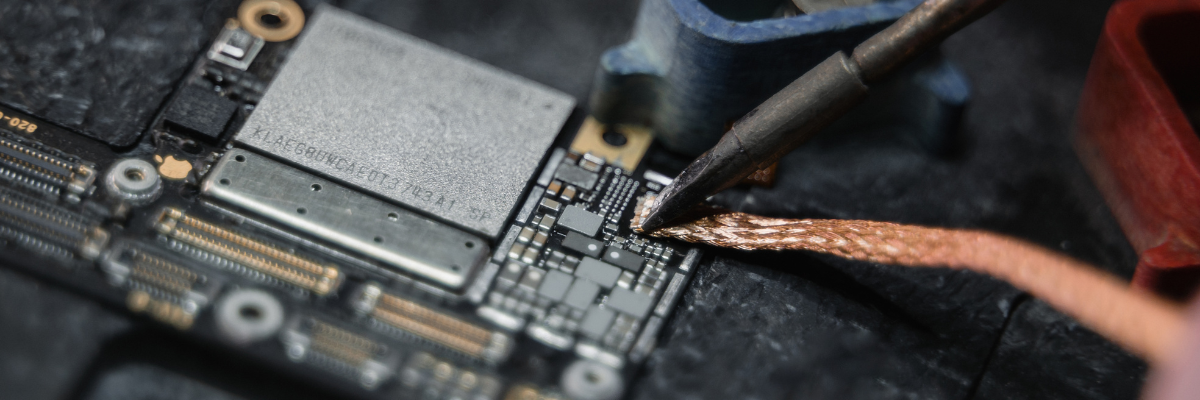Micro-vias are small, laser-drilled holes in printed circuit boards (PCBs) that connect different layers, ensuring seamless electrical conductivity in high-density interconnect (HDI) designs. Widely used in advanced electronics, such as smartphones, wearables, and automotive systems, micro-vias enable compact designs while maintaining optimal performance. Hence, it is imperative to create and strengthen these interlayer connections. Sintered paste, a conductive material composed of finely powdered metals such as silver or copper, is gaining prominence for creating robust electrical interconnects. Known for its superior thermal and electrical conductivity, sintered paste is commonly used in applications requiring high-reliability connections. In this post, we explore the benefits of using sintered paste for micro-vias, key considerations in PCB design, and the testing and validation required to ensure their performance.
Benefits of Using Sintered Paste for Micro-vias
Using sintered paste for micro-vias offer several advantages over traditional methods in rigid-flex PCB designs. These benefits make them a compelling choice for advanced electronics applications, particularly where performance and durability are critical.
- Enhanced Electrical Conductivity: Sintered paste, typically made of silver or copper, provides excellent electrical conductivity. Micro-vias created with sintered paste exhibit lower resistance, enabling faster signal transmission and reduced power loss in high-speed circuits.
- Superior Thermal Performance: Heat dissipation is important to prevent overheating and damage, especially in high-frequency and circuit-dense applications. There is a huge amount of thermal exposure because of multiple layers and high operating frequencies. Hence, there is an increasing need for robust interconnects, which can be achieved through sintering. This makes sintering ideal for applications with stringent thermal management requirements, such as automotive electronics and industrial systems.
- Mechanical Strength and Reliability: The robust mechanical properties of sintered paste ensure that micro-vias can withstand mechanical stress, vibrations, and thermal cycling, which are common in rigid-flex PCBs used in dynamic environments.
- Miniaturization Capability: Sintered paste enables the design of smaller micro-vias, supporting high-density interconnects (HDI). This allows designers to create compact and lightweight assemblies with tight and dense circuits without compromising functionality.
- Improved Manufacturing Yield: The precision and consistency of sintered paste application reduce the likelihood of defects, improving overall manufacturing yield and reducing production costs in high-volume manufacturing.
Key Considerations for Using Sintered Paste in PCB Designs
Designing with sintered paste in micro-vias requires careful attention to several critical factors. These considerations ensure that the benefits of sintered paste are fully realized while minimizing potential challenges.
- Material Compatibility: The choice of sintered paste material must align with the substrate and copper layer properties. Research suggests that copper-based sintered pastes when used along with reducing agents such as carboxylic acid increases shear strength. This enables optimal performance of such rigid-flex PCBs due to their compatibility with materials such as silver and copper that also improve their superior thermal and electrical characteristics.
- Thermal Expansion Management: Rigid-flex PCBs often experience differential thermal expansion between flexible and rigid sections. Sintered paste with high thermal stability mitigates the risk of delamination and ensures robust interconnects under varying temperature conditions.
- Via Filling Process: The application process for sintered paste must be controlled to ensure proper via filling. Techniques such as stencil printing or automated dispensing provide precision, minimizing voids and ensuring consistent performance.
- Surface Preparation: Proper surface preparation, including cleaning and oxide removal, is critical before applying sintered paste. Any contamination can lead to poor adhesion and compromised via integrity.
- Electrical and Thermal Testing: Rigorous testing is essential to validate the performance of micro-vias applied with sintered paste. Techniques such as electrical continuity tests, thermal cycling, and mechanical stress testing are commonly employed.
- Environmental Durability: Research highlights the importance of sintered paste formulations tailored for harsh environments. For instance, additives in paste compositions can enhance resistance to humidity and oxidation, critical for automotive and industrial applications with harsh operating environments.
- Cost and Scalability: While sintered paste offers numerous advantages, its cost and scalability should be assessed relative to project requirements. Advances in paste formulations and manufacturing techniques are helping to make this technology more accessible for high-volume production.
Testing and validation are integral to ensuring the performance and reliability of sintered paste micro-vias. A systematic approach helps identify potential weaknesses and validates the technique for real-world applications.
- Electrical Continuity Testing: This test ensures that micro-vias provide reliable electrical connections across layers. Low-resistance measurements confirm the efficiency of sintered paste in maintaining conductivity.
- Thermal Cycling Tests: Sintered paste micro-vias are subjected to repeated heating and cooling cycles to assess their durability under thermal stress. These tests mimic real-world operating conditions in applications like automotive systems.
- Mechanical Stress Testing: The mechanical strength of micro-vias is tested through vibration and flexural stress tests. This ensures that the interconnects can withstand physical stresses encountered during use.
- Environmental Testing: Exposure to humidity, temperature variations, and corrosive conditions evaluate the resilience of sintered paste against environmental factors. Such tests are crucial for applications in harsh environments.
- Void Detection and Analysis: Non-destructive testing methods such as X-ray imaging or computed tomography help identify voids or defects in the via filling. Eliminating voids enhances the reliability and longevity of micro-vias.
- Surface and Adhesion Testing: The adhesion of sintered paste to substrate surfaces is tested to ensure robust interconnections. Surface roughness and paste properties are critical factors in achieving strong adhesion.
Are you looking for advanced solutions for designing micro-vias with sintered paste for rigid-flex printed circuit boards? At Rigiflex Technology, we offer high-performance and reliable PCB solutions tailored to your needs. Our expertise ensures superior durability and precision for demanding applications. Partner with us to achieve unparalleled quality and customization of your PCB assemblies. For inquiries or custom requirements, contact our sales team today.

